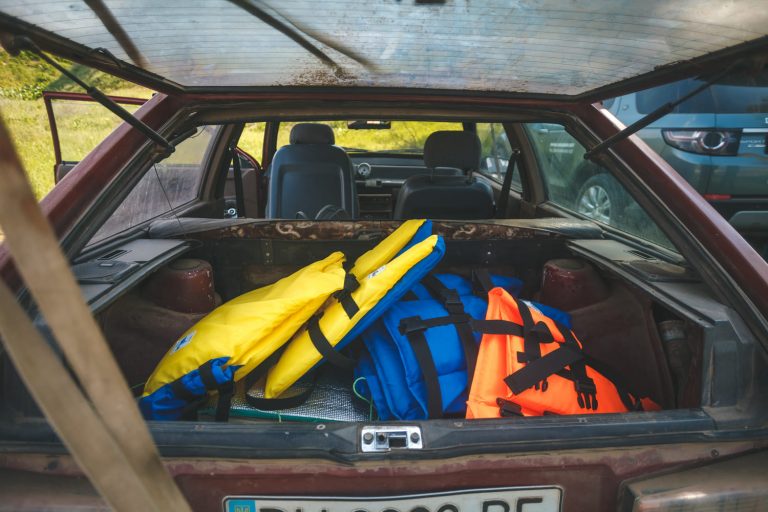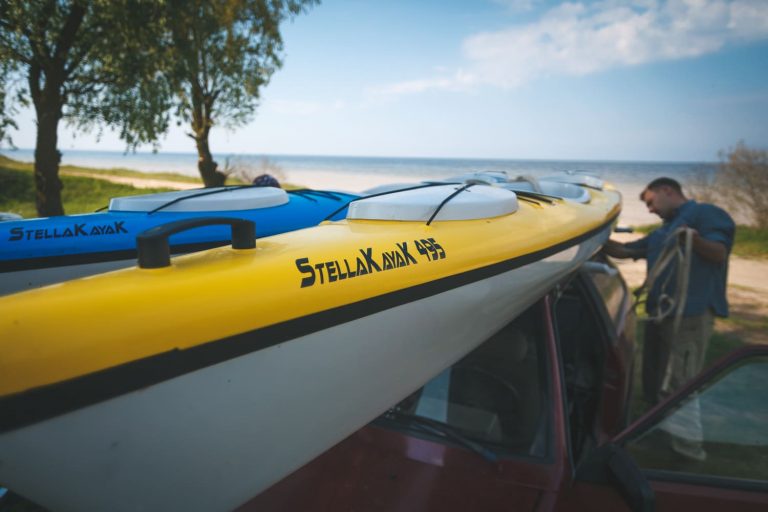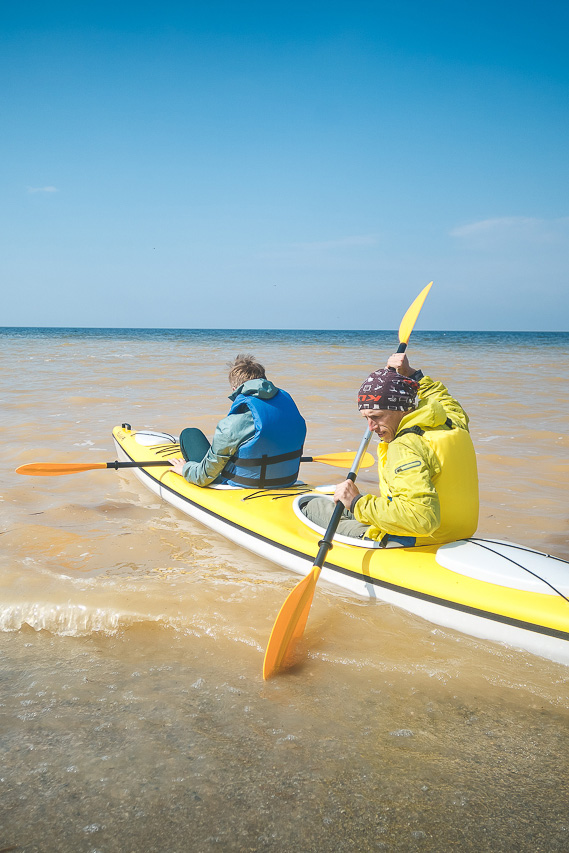There are many wonderful and off-the-beaten-path destinations with incredible nature in Ukraine. In early 2010, Andrii Kuzmenko and his band ‘Skryabin’ showcased one of them in their music video, “Місця щасливих людей” (‘Places of happy people’ – ed.). It was shot at the Stanislav cliffs on the Dnipro-Buh estuary in the Prychornomoria region.
Several years later two local lads, Oleh Marchuk and Andrii Holinko, moved back to their home village, Oleksandrivka, and started promoting tourism in the region. They launched a tour agency and now organize kayaking tours there.
Near Oleksandrivka village, the salt waters of the Black Sea meet the Southern Buh and Dnipro River deltas creating the picturesque Dnipro-Buh estuary. On its shores, forty-metre, steep, clay escarpments rise – Stanislav Cliffs – or simply “The Cliffs” or ”The Kherson Mountains”, as the locals call them. In ancient times, the Scythians and Olbians lived here, centuries later the Cossacks would set up their winter shelters here. Whoever the residents were, they fished in nearby waters. However, due to poaching and overfishing, the river has ceased to be the primary source of income for the villagers, who are abandoning their villages in increasing numbers to seek jobs elsewhere. But the two friends have demonstrated that treating this land of salt lakes and estuaries differently can unlock new potential.

Oleh and Andrii
Oleh and Andrii are childhood friends. They both grew up in Oleksandrivka and were passionate about travelling and spending time in nature. As most of their peers, they settled down in cities as adults, trying to realize their full potential. Oleh moved to Kryvyi Rih, where he both studied and worked as a manager. Andrii received a Meteorology degree in Odesa. However, these two friends could never get accustomed to the pace of life in a big city.
Oleh was the first to return. He explained that after the economic crisis of 2008, trouble was starting to surface at work, so he left his job and moved back to Oleksandrivka. He recalls that once back at the village he spent several years trying to discover what he wanted to do in life. At the time his hobby was photography and video-making – so he decided to try to make a career of it; he bought the equipment and started shooting. However, simply making money was not enough for Oleh. What he wanted, he says, was to do something not just for himself, but for others as well. When Andrii returned to the village, Oleh found in him a like-minded person who hadn’t gotten used to the big city life either.
– Before this [moving back] my daughter was born, and I realised that it would be better to raise the child somewhere unpolluted, with healthy, natural products and an eco-friendly environment.
Oleh says that he just couldn’t seem to stop thinking about how to improve, at least a little bit, the living conditions in his home village.
– I’ve always wanted to do something for the villagers. I was like, ‘Yeah, I’m kinda OK, I don’t need to go elsewhere to earn money. But still we aren’t doing anything for the village.’ We continued to brainstorm… we wanted it to be something that was not expensive, but interesting.

From the start the friends recognised the untapped potential of Oleksandrivka and nearby villages, so this was the insight that they focused on. Oleh remembers how he had come across a photo of kayakers (kayaking is a type of sport or leisure activity on long narrow paddle boats – ed.), shot somewhere in Hawaii, and thought it would be worth trying something similar here. As an aside, among kayaking fans there are two names for the boat – kayak and baidarka. Some consider the two synonyms, others distinguish between them arguing that kayaks are always rigid, while baidarkas can be portable (the word ‘baidarka’ is popular mostly among Slavic peoples; in Western culture the common word for this type of boat is ‘kayak’ – either ‘rigid kayak’ or ‘folding kayak’. Canoes are often confused with kayaks/baidarkas – ed.).
The two friends explained that people kept telling them, ‘Tourism doesn’t belong here’. Oleh remembers people’s reactions to his photographs that were posted in Oleksandrivka and Stanislav (the neighbouring village – ed.) Facebook groups, which he moderates. Instead of simply admiring the beauty on their doorstep, people’s comments focused on the piles of garbage in the background. But Oleh explains why he believes that it’s important to focus on the positive:
– If we can get people used to something beautiful, then, maybe they will start to notice it themselves. And someday perhaps they will think: ‘Nah, I won’t dump my trash, it’s so cool here.’
Oleh recounts that the company name ‘Skelka Tour’ (‘skelka’ is the diminutive word for ‘slope/cliff’ in Ukrainian – ed.) was coined by his wife, Svitlana. They loved this name right away, as it hints at two peculiarities of their region: ‘The Cliffs’ on the coast of the estuary and the ruins of the antique settlement – also called ‘Skelkas’ – which used to be in Olbia state. Oleh adds, that he wonders if without the support of his family he would have been able to devote himself to this project fully.
– It’s so good that I have a wife who supports my kind of ‘stupid’ ideas. And when I tell her: ‘Sorry, honey, but today we won’t be able to finish our home renovation, but rather we’ll invest in something crazy’, she says: ‘Well, okay. It is what it is.’

Skelka Tour
The first thing that the project founders did was buy the kayaks. Initially, they paddled along the local bodies of water on their own to test the boats, explore the surroundings, and think through tour routes.
– We bought them and had no idea how they would actually work on the water. We tried them both on calm and stormy waters. It was awesome – we never capsized and only once ended up a little bit wet – that’s it.
The first three kayaks were ordered for ‘Skelka Tour’ from Stryi, then they switched to fiberglass ‘Jazzy kayak’ models produced in Svitlovodsk. Now their fleet consists of twelve two-person kayaks with an additional child seat. The lads note that the idea behind buying this specific model paid off – they are easy to navigate, safe, and you can “catch waves” on them.
– It’s cool to kayak on high waves, if one fancies something like whitewaters in mountain rivers. It’s super cool. And it’s safe since the kayaks don’t turn over.


slideshow
As soon as the kayaks appeared, tourists appeared, Oleh and Andrii joke. The organisers started promoting their project through social media, regularly posting photos and videos from the trips. In 2018, they hosted around 500 tourists, Oleh says. Most of them came from the southern regions of Ukraine, some – from the west or the capital (Kyiv – ed.).
The founders of ‘Skelka Tour’ created two tourist routes. The first one meanders through the Dnipro-Buh estuary – tourists paddle kayaks along the right bank of the estuary for 5 hours. They can admire ‘the Kherson Mountains’ and take a photo-stop near the antique settlement of ‘Skelka’. Another break is for lunch – Oleh and Andrii treat guests to Prychornomoria fish soup and indigenous herbal tea. Additionally, the local fables they share are a must-have of the program.
The second route goes through the territory of Nyzhniodniprovskyi National Park, in the floodplains of the Dnipro river. Unlike kayaking through the wide, open waters of the estuary, where, according to Oleh, waves help to ‘catch’ some adrenaline, this option is calmer. Such an activity takes from six to eight hours. Organisers say this area of the Dnipro delta is the only part of the biggest river in Ukraine that is not much affected by harmful human activity. The lush flora is also a nesting place for endangered birds like the pink pelicans and the European roller. Kayaks, adds Andrii, are perfect watercrafts to marvel at all the beauty of nature while not harming it.
– It’s awesome that they are so high-speed that just 1-1.5 hours outside the village we find ourselves somewhere in the wild where there are no people, where birds nest, where it’s peaceful. You can meander wherever you want, through floodplains or whatever. Now you’re paddling in the open water, and in a moment you’re floating among birds, animals, and so on.

People really like such leisure activities and by the end of the first year the number of tourists has doubled. ‘Skelka Tour’ has recently started to offer a 2-day tour along the Dnipro delta – through mazes of floodplains, islands, lakes, and creeks. The founders deliberately arranged a route to avoid populated areas, which is how one can feel the peace and calm of the big river.
From 2019 ‘Skelka Tour’ has been hosting tourists year-round. According to the friends, they are the first ones in the region to hold winter kayaking tours. Oleh assures that it is safe and comfortable, as kayaks are the typical mode of transport among the peoples in the northernmost part of the hemisphere and can withstand low temperatures. Winter trips are conducted only in case of windless weather since it is possible to do without wetsuits or other special clothes.
Oleh and Andrii care for the comfort and safety of their tourists – they provide guests with all the necessary gear: life jackets, dry bags, and radio equipment.
The ‘Skelka Tour’ organisers are finishing a campsite on the shore of Solonets Lake, near Oleksandrivka. They are bothered by the lack of accommodations where tourists could spend the night. Meanwhile, plenty of houses are empty while their owners are working elsewhere. Oleh and Andrii suppose that were the houses for rent, it would both bring some income to the owners, and life to the village. They discussed the possibility of receiving a land grant for the campsite with local authorities of both villages, and with residents about renting out empty houses for tourists. Having received no help from the public administration, they partnered with a local entrepreneur to set up the campsite.

Green tourism for kids
The two friends share that ‘Skelka Tour’ is a project inspired by their childhood. When Oleh was a kid, there used to be docks with boats and catamarans in Oleksandrivka, and in nearby Stanislav there was a marina, where sportsmen would come for training. Now he is startled that children barely come here to bathe, as they simply cannot swim.
Andrii adds that they spent their whole childhood in nature: swimming, exploring the environment, and organising various field trips. That is why, in addition to promoting the beauty of their land, through ‘Skelka Tour’ trips, they want to create an example of how to make leisure both enjoyable and time well spent.
– Those who grew up here, used to hang out around here all the time. They would go fishing or play with the kids – and that’s it. When they see photos from our trips, they’re like ‘Wow, where is this?’. ‘Well,’ I say, ‘here, just a hundred metres from your house.’
The two friends also wish to set up a school for kids. They admit, though, that so far this is just an idea, as they don’t know where to start and how to implement it yet. But they are determined to, Oleh assures, increase the understanding of tourism among children.
– There are kids who have never been to our waters. They don’t know what traveling is, except, you know, sunbathing-and-beach-like tourism with their parents. And we want to show them that tourism can be different – for example, it can be active, with backpacks.

Oleh says he would like to develop an organic learning process in the school. He imagines this project as something like a tourism club: hosting lectures, trainings or camping trips with invited guests like travelers, sportsmen, and coaches. Apart from the school and setting up the aforementioned campsite, Oleh is thinking about opening a cafe.
‘Skelka Tour’ founders have already seen the changes sparked by their project and are excited about them.
– Over the last two years that we’ve been coming here (to Stanislav beach – ed.), we’ve noticed much less trash. This year there’s almost no garbage at all!
Oleh and Andrii are sure that there are many other places where projects like ‘Skelka Tour’ can be organised. They’re confident in the potential of local eco-tourism, which helps people both to make a living in their home villages and change life there for the better.


